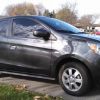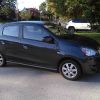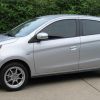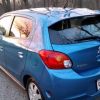Apologies in advance, this is not a short answer.
There are definitely mixed opinions on the topic, and you're not wrong. Swaybars are definitely used for fine-tuning suspension. But, "real" suspension tuners will tell you to do the coarse suspension tuning with spring rates, and fine tuning with bars.
FWD cars in the "hairy edge of suspension performance" realm are quite simply fighting understeer. It's what they inherently do in a corner. 60-65% of the weight is on the front tires, and the front tires are driven. It's a recipe for understeer. So, MUCH of what we do when tuning the suspension of a FWD car is in an effort to fight the understeer.
If you're playing with swaybars, basic theory states that pretty much anything you do to stiffen one end of the car relative to the other end will cause that end to lose grip earlier relative to the other end. So, if you've got a car that oversteers (high-powered RWD car that wants to go tail out when you apply throttle on corner exit), you put a larger bar on the front, and a SMALLER bar on the rear to shift the bias towards understeer. The extreme example of that would be making the front roll stiffness SO stiff that the car lifts a front wheel... while transferring all of that weight to the rear. (theoretically, the opposite corner, but it gets distributed "some" to both sides of the opposite end)
Apply that same logic to a FWD car. You want a larger rear swaybar to transfer more of what little weight there is in the back of the car (we're talking about 40% weight on the rear, so 20% weight on one rear corner... that's the max you have to work with) to the front during hard cornering. Adding a larger FRONT bar would counteract that improvement in balance. You wouldn't get that transfer of weight to the front if you balanced it out with a stiffer front bar... instead, you'd just get a stiffer car. It might FEEL better because it's stiffer and much more responsive, but you'll still have the same understeer problem at the limit that you started with. And if you just put a big rear bar on, you lift the inside rear tire in a turn (just like the RWD car lifts the front), which is perfectly okay because the rear of the car isn't doing anything, anyway.
HOWEVER... MacPherson Strut suspensions are weird. They typically have a very poor camber curve (as opposed to something like a double-wishbone suspension that can gain LOTS of negative camber under cornering loads to keep the tire contact patch nice and flat). The body might roll 8 degrees, but the McStrut suspension will only gain 5.5 degrees of negative camber, leaving you with a compromised contact patch. (I made up those numbers, probably not accurate for anything, just making the point)
SO... some FWD cars, particularly cars like 80's vintage Golfs, actually work better with a HUGE front swaybar to simply lock down the front suspension. Make it so stiff that it never rolls more than 3-4 degrees. Then you have 3-4 degrees of static negative camber, and you have a good contact patch at full tilt.
They call suspension tuning a dark art for a reason! Everything affects everything else, and there are no easy answers.
On my Mirage, I was having a SERIOUS problem with the inside front wheel lift. The inside rear would lift, which is typical and normal for a hard-pressed FWD car. But, when the front starts coming up with it, you're dangerously close to being on your roof! I was doing everything I could to address that issue (the cause of which is simply that the car is narrow and tall, top-heavy, physics is working against us). The front swaybar inherently LIFTS UP on the inside front tire. That's what it does. Body roll forces the outside end of it up (relative to the chassis), and the opposite end of the bar wants to go up with it... unloading the inside tire.
In my case, I didn't want ANYTHING lifting up that inside tire. But, you're also talking about a FWD car without a limited slip diff... you really don't want to unload the inside front tire any more than it already is, or you'll just introduce wheel spin while you're trying to accelerate out of the turn. Which makes you delay your throttle input, and ultimately makes you slower coming out of the turn. So... I actually removed my front swaybar. I don't have on on my Mirage at all! I don't generally recommend doing that. But, in my case, I was fitting significantly stiffer front SPRINGS at the same time. So, I got my roll resistance from spring rate rather than bar... and spring rate doesn't cause inside wheel lift!
If you want to take that thought a step further, what I've learned through lots of experimenting with FWD cars, and then later understood by reading a good suspension book, is that when you fit that rear bar and it's stiff enough to lift the inside rear wheel (which doesn't take much... a LOT of FWD cars will lift the inside rear under hard cornering in stock form)... as soon as the inside rear wheel lifts, all of your roll resistance now transfers to the FRONT of the car, the rear bar is out of the equation at that point. If you've got a lot more roll resistance in the rear vs the front (big ass rear bar), as soon as the inside rear lifts, the car FLOPS onto the opposite front corner! That's another issue that I was trying to address with stiffer front springs. A smoother transition when rear wheel lift occurred.
Anyhow... the front bar on the Mirage is a beast to get to. You have to drop the front subframe to get it out. I opted to just cut mine in the middle with an angle grinder and pull it out. It's a convoluted piece. Would not be easy to make a replacement for it.
Oh, and you'd be adding weight to the front of the car.

For a street car, you're probably less concerned with handling at the limit, and maybe a larger front bar would help the car FEEL better. And in some cases, fitting a larger front bar is easier than messing with the rear (like the Mirage, which has no rear bar... and adding one makes the car ride rougher because it's taking away from the somewhat independent nature of the very twisty rear beam axle). My Driver's Ed car is a Kia Rio... and when we bought an almost identical Hyundai Accent, we learned that the Accent had much better steering feel. Same suspension! Same car! Turns out the Accent has a larger front swaybar. It's the only real difference between the two cars other than tire size. (the Kia has the better tires) So, when I was replacing shocks on the Kia, I hit up eBay and sourced an Accent front bar and installed it. Counterintuitive for COMPETITION purposes... but, it gave the car a little crisper steering feel and only cost me $60.
So, again, the dark art of suspension tuning. Or car tuning in general. Everything affects everything else. What YOUR specific goals and budget are is always a factor.
For competition purposes, FWD cars are almost always set up to where they almost oversteer. The suspension setup is so weird, and so biased toward reducing understeer that you're always one little driver input error away from being backwards! Dive into a slalom and drive it like you mean it, you're fine. Dive into a slalom, realize you're going to fast and lift off the gas while you're turning? As soon as you lift, you're shifting weight off of the rear of the car... and it's already got the absolute minimum on it already. You're going tail-out instantly. If the car is properly set up, and you're on your game, you can usually catch it by jabbing the throttle and transferring that weight back to the rear. But, if you put an inexperienced driver in a properly competition-prepared FWD car and tell them to go hammer it... they're going to spin.
Okay, I'm done rambling. Much of what I've said is not fully relevant to a street car. You shouldn't be tuning the suspension to that extreme. You don't want an "unstable" car on the street. Cars are designed to understeer a little bit because it's safer and more predictable. But, you can definitely tune out SOME of the understeer.



 Shelby
Shelby Zero
Zero Zero Sen
Zero Sen



 Reply With Quote
Reply With Quote Heartbreaker
Heartbreaker Project Blasphemy
Project Blasphemy
 Puttster 2
Puttster 2 2002 Mitsubishi Delica Space Gear L400
2002 Mitsubishi Delica Space Gear L400
 Underdog
Underdog
 Speck
Speck